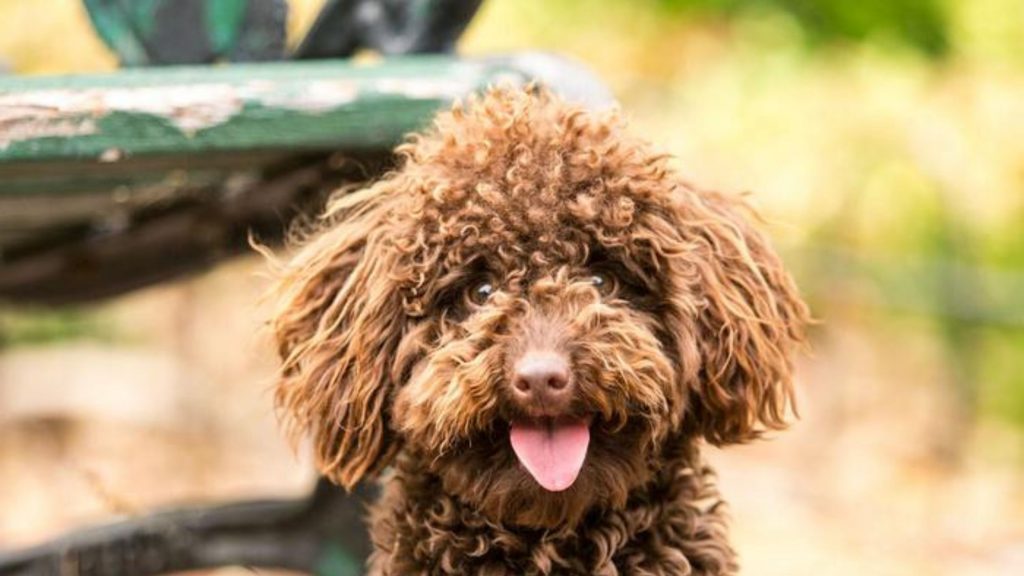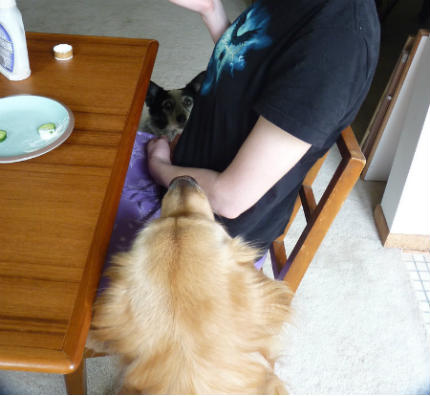As with the bad shi, the labradoodle is another of those dogs that have been developed “in the laboratory” , consciously mixing two breeds of dogs, the Labrador and the poodle, giving rise to this dog that looks like a teddy bear.
- Size : 45 to 55 cm
- Weight : between 10 and 25 kilos
- Hair type : long and wavy, although there are specimens with straight hair
- Character : calm, sociable and cuddly
- Health : good, although they suffer from several genetic diseases
- Life expectancy : 14 years
Origins of the Labradoodle
The Labradoodle is one of the few dogs in the world that has its origins documented, so we know the exact year it originated, specifically, 1988.
On that date , Wally Conron came up with the idea of creating a guide dog for blind people that did not shed , since blind people with allergies could not enjoy a guide dog.
One of the breeds was clear, the Labrador, and the other chosen was the Poodle , which was very intelligent and also did not shed hair, being what is known as a hypoallergenic breed.
Over the years its creator has regretted his idea, as he believes that his initial motivation has been perverted and now this animal is only raised in order to make money, something in which he is right.
Furthermore, it seems that there are some problems with the health of many specimens, although in the United States and Australia they have already started to work with the idea of professionalizing the breeding of the breed.
In fact, the Kennel Club of the United States has recognized the Labradoodle , something that we think will take a long time in Europe, where we can buy it without any type of documentation proving that it is a pure breed.
Labradoodle Characteristics
Being such a recent breed, not recognized in a good part of the world and on which work is currently being done, these characteristics are only a guide, as there are several different types of Labradoodle.
Thus, it has a very long coat that is usually wavy , although it is not uncommon to find specimens whose hair is straight or curly, and something similar happens with the colors, among which there are many different shades.
We see white, black, caramel, silver, blue, gold dogs and all of those colors combine with each other, being valid at this time as there is no clear standard or guidelines on which are desirable.
The size is medium, and something that immediately identifies them are their two long ears, which hang and move when this dog runs.
It weighs between 10 and 25 kilos, which is a large variation and here we see again that there is a lot of variety in the different animals, measuring between 45 and 55 cm.
Because over the years they have been bred without any type of order, some of them have lost the quality of being hypoallergenic, which was the reason why this breed was created.
There are several types of labradoodle and the one that wants to prevail is the Australian labradoodle , since breeders are fighting to create a breed that has a defined standard, using others such as the cocker spaniel or the Irish terrier, always with the idea of set physical characteristics.
The mixture has sometimes not given good results, since many dogs are created with an overly nervous character.

Labradoodle Character
Again, and taking into account that everything is provisional and changes a lot from one dog to another, as a general rule this is a sociable and very happy breed, which loves cuddles, children and family life.
At the same time, he has a much higher than average intelligence and always wants to please his owner, which, on the one hand, makes him useless when it comes to guarding, but on the other hand, makes him one of the best assistance dogs. , which is what it was created for.
This is not always the case, and sometimes it can give us more problems than we thought at first, since it is a cross between two hunting breeds , so instincts can come to light and that would not make it suitable as a therapy animal. .
With good early education this can be redirected, so you have to start early with it.
Labradoodle Education
One of the first tasks when we are training a Labradoodle is to teach it to come to our call, which is the most difficult because the breeds from which it comes have a great hunting instinct.
Here positive training will be our best ally, especially with a dog as intelligent and sensitive as this one, using rewards every time he does something well. Of course, violence is totally out of place, plus it would only scare him.
With patience we can make great progress, since we must not forget that they have been used, and continue to be used, to help people with vision problems and that they are also excellent therapy dogs.
It would not be a bad idea to go to a dog school , at least at first with the intention that they help us in the initial training and in it we can practice Agility, since their intelligence and agility make them very good in this discipline, although there are some specimens who are reluctant to practice it.
Labradoodle Health
It is its weakest point, since although it is not a sickly dog, it does have several hereditary diseases that come from having crossed the poodle and the Labrador without any control.
We always read that mixed-breed dogs are more resistant and this is true, but after many years of natural selection in which the sickest ones end up dying, only the strongest ones reproduce.
This is not the case with the Labradoodle, which is prone to hip dysplasia , elbow dysplasia, and progressive retinal atrophy. In addition, you can also suffer from skin problems due to the mixture of both hairs of two very different types and malformations in your teeth.
That does not mean that you will have these diseases, but it does mean that you will be prone to them and that they may appear throughout your life .
Now “the ball” is in the court of breeders, who must get to work to banish these pathologies with selective breeding and genetic testing, stopping breeding with those dogs that have them.

Labradoodle Care
As with the Labrador, this breed is prone to being overweight, so we must control what we feed it, leaving aside treats and giving it quality feed , without grains or cereals.
The hair is another of the specific care items for the Labradoodle and the heaviest of all, because due to the quantity and length it has to be brushed daily, or else it ends up being a bunch of knots.
Its hair can be cut, but if we don't want to brush it often it is better to opt for another breed with a short, smooth coat.
Continuing with the specific care, the ears can also cause us some problems, because sometimes they have hair inside and when they fall down, ear infections will soon appear if we are not careful.
They must exercise and they like to swim like Labradors , so perhaps they are not the best dog to spend the day locked up in a small apartment, and it is more convenient for them to live with us in a chalet with a plot or in a country house. .
Adopt a Labradoodle
In Spain it is not a popular breed, although it is possible to see the first specimens, but they are not common in shelters.
We can look for them, since over time it is possible that we will find one, but if we find it we have to be careful, because some specimens do not have the best character in the world and it is likely that they are in a shelter for that reason .
Retraining an adult animal is something that can be done, but it is not within everyone's reach. Therefore, if we find a Labradoodle, it is advisable that we spend some time with it, or even consult the possibility of living with it at home a few weeks before the final adoption.
This helps us know how it behaves, and if we like what we see we will really enjoy it, especially if we are fond of going out into the countryside and have a nearby watercourse or swimming pool at home.
Other dog breeds that may interest you:












